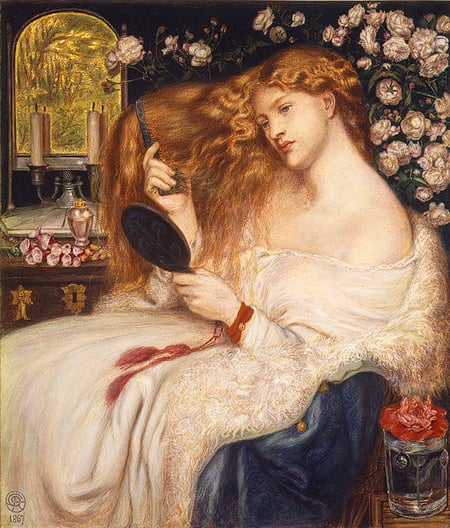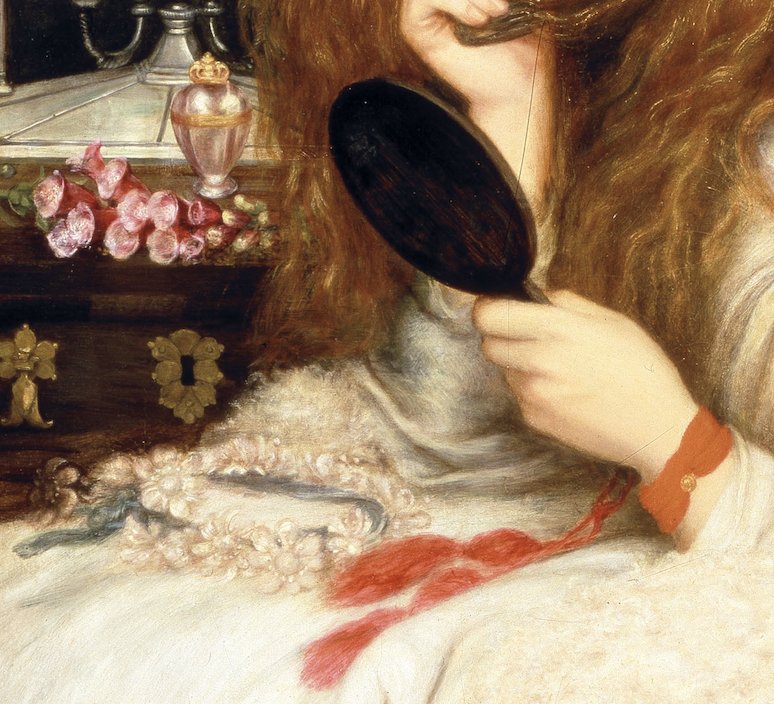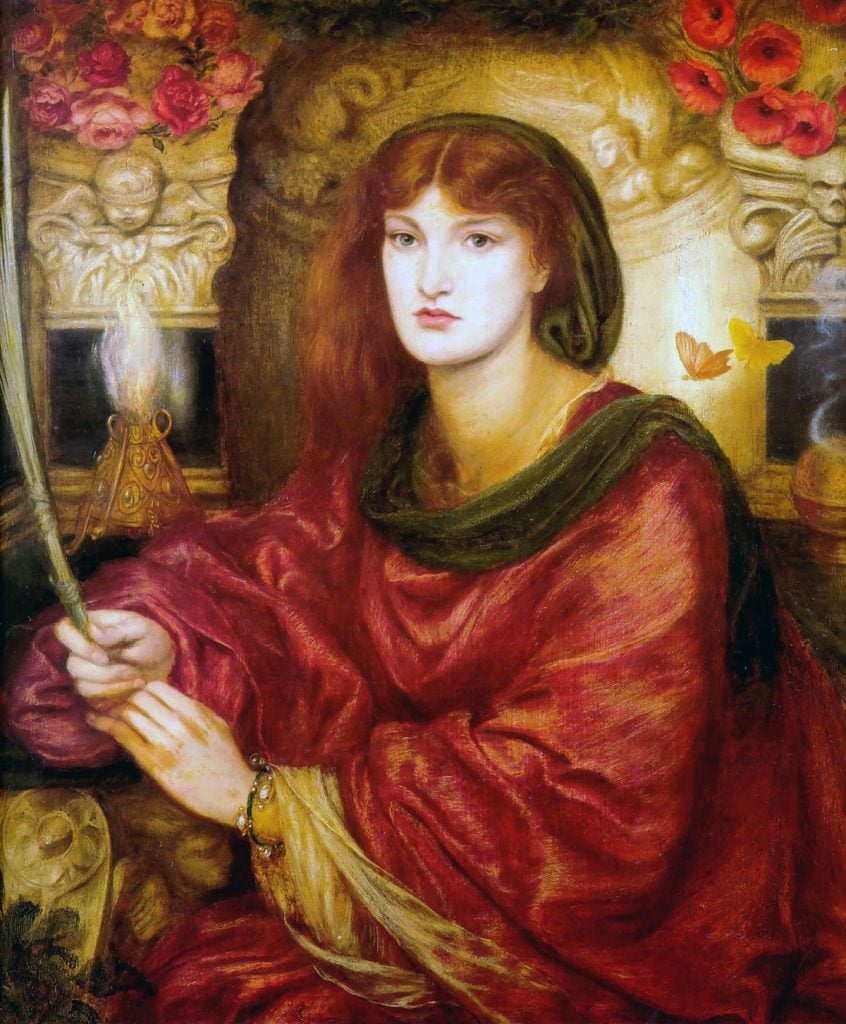In the cultural ether of Victorian England, Lilith – a former Talmudic seductress and the mythical first wife of Adam – emerged as a figure of renewed fascination with popular culture and embodied societal anxieties around the changing role women in the 19th century.
References to Lilith date back to the ancient Mesopotamian poem Epic of Gilgamesh (2100 BCE) and ancient Judaic texts dating to the second century. In these, Lilith is depicted as an illusory demon, flashing blackness, nearly formless in design. In medieval times, however, rabbinical texts elaborated on this darkened face, describing Lilith as a rebellious equal to Adam (made of the same clay soil, unlike Eve, who came from her rib). In a fit of fury, Lilith is said to have left Eden, spawning a wave of demons and swearing to kill the children of Adam and Eve (some popular etymologies suggest that the word “lullaby” derives from the Hebrew “Lilith-Abi” meaning ” Lilith, go away”). Nonetheless, over the millennia, Lilith has been relegated to sneaking into the recesses of European stories.
This suddenly changed in 1808 when Johann Wolfgang von Goethe’s seismically influential play Faust debuted – Lilith appears as a central character, Adam’s first wife, a beautiful temptress who seduces and defeats him. The capital piece has inspired many literary allusions, including John Keats’ series of poems “La Belle Dame Sans Merci” (1819). The earliest known painting of Lilith from the 19th century is believed to have been by Queen Victoria’s painter Richard Westall, who took direct inspiration from the room with his 1831 painting. Faust and Lilith. The most influential portrayal, however, would not come for about three decades, when the founder of the Pre-Raphaelite Brotherhood, Gabriel Dante Rossetti, completed his Lady Lilith in the mid-1860s (1866–68; modified 1872–73).
Lilith was a natural fit for Rossetti. Seeking a return to the aesthetics of Quattrocento Italian painting, Pre-Rapheelite artists exalted luxurious colors and intricate detail, drawing their subject matter from legends, myths, poetry and folklore. Women were almost always at the center of these compositions, portrayed as heroines, damsels and seducers of the literary imagination and modeled by the female artists, muses and wives of the Pre-Raphelite milieu. Lady Lilith embodied all of these elements: Rossetti’s depiction depicts Lilith brushing her long blonde hair and gazing at herself in the mirror with sensual self-possession – the hand mirror aligning Lilith with depictions of Venus, further embellishing her transformation to the 19th century from a demonic spirit into a femme fatale.
Right away, Lady Lilith is a centerpiece of Tate Britain’s ‘The Rossettis’, an exhibition that delves into the varied endeavors of the famous Rossetti clan, including the poetry of Dante’s sister, Christina Rossetti, as well as works by his wife and muse Elizabeth Siddallfully fledged painter. The landmark exhibition also marks the first retrospective of Dante Gabriel Rossetti at the Tate and the biggest exhibition of his iconic images for two decades. Lady Lilith appears on loan from the collection of the Delaware Museum of Art, where the exhibition will travel in fall 2023.
On the occasion of the exhibition, we looked at Rossetti’s infamous Lady Lilith and found three facts that can make you see it in a new light.
Rossetti paints on her lover’s face
 Lady Lilith (1867) by Dante Gabriel Rossetti and Henry Treffry Dunn. Collection of the Metropolitan Museum of Art.
Lady Lilith (1867) by Dante Gabriel Rossetti and Henry Treffry Dunn. Collection of the Metropolitan Museum of Art.
Rossetti, for all his radical and bohemian leanings, was not always friendly to the women in his life. During his long courtship with Elizabeth Siddall – whom he long refused to marry due to her low social status – he was involved in several affairs, including with Fanny Cornforth, his muse and governess. Cornforth served as the original model of Lady Lilith in his 1866–68 state of completion. For reasons that are not entirely clear, between 1872 and 1873 Rossetti replaced Cornforth’s face with that of Alexa Wilding, another prominent Pre-Raphaelite model. The replacement may have come at the request of shipping tycoon and Rossetti collector Frederick Richards Leyland, who displayed the painting along with five others by Rossetti in his home.
An 1867 watercolor and gouache by Rossetti and his assistant Henry Treffry Dunn, now in the collection of the Metropolitan Museum of Art, offers us a vision of Cornforth as Lady Lilith. To this version, Rossetti affixed a verse from Faust, as translated by the poet Percy Bysshe Shelley, to the label on its frame. The verses read, “Beware of her blond hair, for she excels / All women in the magic of her locks / And when she wraps them around a young man’s neck / She will never set him free again.”
In 1881, Rossetti will compose his own sonnet which he will add to the final version of Lady Lilithdescribing Lilith as “subtly contemplative of herself / Draws men to gaze at the shining web she can weave / Until heart, body and life are in her grip”.
The devil is in the details

Detail of Dante Gabriel Rossetti Lady Lilith (1866–68; 1872–73). Collection of the Delaware Art Museum.
The Pre-Raphaelites’ passion for painted detail often inserted symbolic meaning into compositions as well. Here, the flowers that surround Lilith offer a bouquet of meanings. The poppies at the bottom right of the painting are an allusion to opium and death. Foxgloves, in Victorian times, symbolized keeping secrets and insincerity. Some believe that the white roses in the background suggest Lilith’s cruel detachment – the white roses would have blushed in Eve’s presence. Yet others believe that the white of the roses is a virginal contrast to the blood red of the poppies, suggesting Lilith’s earthly balance between the two realms.
Another detail alludes to Lilith’s ancient origins: the red ribbon tied around her left wrist. In some Jewish traditions, mothers would tie a red string around their baby’s wrist to ward off Lilith, who had promised to punish the children of Adam and Eve. Here, however, Lilith wears the bracelet herself – a chilling allusion to her powers. In many ways, this alignment of vanity and evil powers underscored the tensions in Victorian society as women left entirely domestic existences behind. “She represents the new woman, free from male control, the scourge of the patriarchal Victorian family,” wrote historian Virginia M. Allen.
It’s Rossetti’s evil twin to another, more virtuous portrayal of beauty

Dante Gabriel Rossetti, Sibyl Palmiferous (1866).
Lady Lilith was intended to be paired with another of Rossetti’s paintings, Sibyl Palmiferous (1866–70). Wilding served as the model for this composition and it is possible that Rossetti repainted Cornforth in Lady Lilith to make the relationship between the two compositions more apparent.
While Lady Lilith is a representation of the vanities and inconstancy of bodily feminine beauty, Sibyl Palmiferous It is said to represent the beauty of the soul. Rossetti also affixed a sonnet to the frame of this work. The palm, with the butterflies, suggests the spiritual nature of the painting. At the same time, the palm indicates to the viewer that the painting, just like Lady Lilithis more interested in the male response to female beauty than in women themselves: palmiferous or “palm-bearer”, according to Rossetti’s poem, offers a palm to the man she permits to possess it. Fully covered and seated in a sort of throne, Sibyl Palmiferous offers an idealized model for the Victorian woman.
Both paintings were published with their respective sonnets in the catalog, Notes on the Royal Academy exhibitionin 1868. Then, in 1881, the poems were renamed—”Lilith” to “Body’s Beauty” and “Sibylla Palmifera” to “Soul’s Beauty”—making the contrast even more apparent.
‘The Rosettis’ is on view at Tate Britain, Millbank, London, until September 24.
Follow Artnet News on Facebook:
Want to stay one step ahead of the art world? Subscribe to our newsletter to receive breaking news, revealing interviews and incisive reviews that move the conversation forward.
